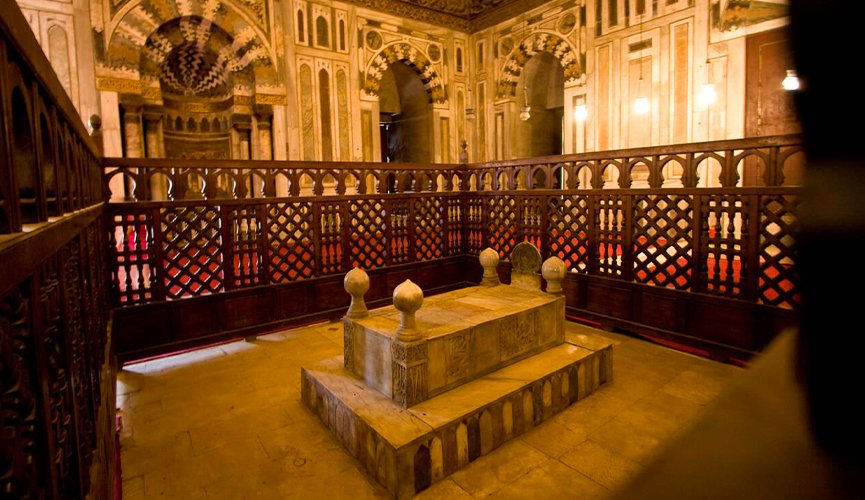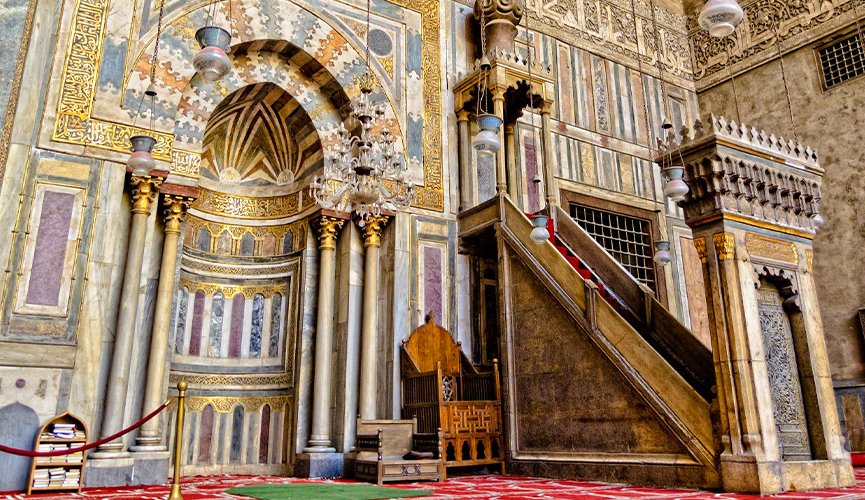The Mosque of Sultan Hassan is an architectural masterpiece in the heart of Cairo, Egypt. This mosque was built between 1356 and 1363 by Sultan Hassan, one of Egypt’s most potent Mamluk rulers. The mosque was designed by renowned architect and engineer Muhammad ibn al-Zahran, who had also designed the famous al-Azhar Mosque.
People talk about how big and beautiful the Mosque of Sultan Hassan is, and it is one of the biggest mosques in the world, with a total size of 7,906 square meters and four prayer halls arranged around a central space. The mosque also has beautiful minarets, domes, carvings, decorations, and a splendid washing pond.
The Mosque of Sultan Hassan is essential because of its architecture, art, and historical and cultural value. It represents the Mamluk era in Egyptian history, characterized by beautiful structures, commerce, and cultural exchange. Muslims worldwide came to pray and learn at the mosque for religious and social events.
The Mosque of Sultan Hassan is still a significant building in Cairo, and people come worldwide to see it. Its beautiful design and long past continue to inspire builders, artists, and researchers, which makes it a must-see for anyone who visits Cairo.
The Architecture of the Mosque

The exterior design of the Mosque
A team made it of skilled builders and workers, and the outside is complex and beautiful, with tall minarets, extensive gardens, and beautiful architectural details. The exterior of the Mosque shows how skilled and creative Islamic builders were, and they used complicated geometric patterns and brickwork methods to make this fantastic building.
The interior design of the Mosque
When people enter the Mosque of Sultan Hassan, they can be amazed by its beauty. The walls of the Mosque have beautiful Islamic writing and complex geometric designs that were made with great care. The prayer nook, or mihrab, is an essential part of the Mosque, and it is a work of art made of marble and colored stones that are beautifully put together.
Islamic Art and Symbolism in the Mosque
The form and decor of the Mosque of Sultan Hassan are based on Islamic art and symbols. There are many religious symbols in the Mosque’s designs and carvings, such as geometric patterns, Islamic writing, and pictures of plants and animals. The Mosque also has colorful stained glass windows, painted tiles, and elaborate sculptures; all meant to show off the beauty and complexity of Islamic art.
Overall, the Mosque of Sultan Hassan shows how intelligent and creative Islamic buildings and design can be. From its beautiful outside to its detailed inside and use of Islamic art and symbols, this Mosque is a lovely and historical wonder that continues to amaze and inspire people worldwide.
Detailed Overview of the Mosque’s Features

A. The Mosque’s Court
The Mosque of Sultan Hassan in Egypt is an excellent example of traditional Islamic design. The mosque’s courtyard is a big square with four domed rooms, or iwans, on all sides. The area has a beautiful pond in the middle and is lined with marble. This open area gives people who come to the mosque a sense of peace. The court is also decorated with Islamic designs, writing, corbels, and geometric patterns.
B. The Main Prayer Hall
The mosque’s prayer hall is a big, rectangular room with pointed arches held up by many marble columns. Sunlight comes in through the clerestory windows and lights up the inside of the hall. The center dome of the mosque is one of the biggest in the world, 21 meters in diameter and 52 meters high. More than 4,000 people can pray simultaneously in the prayer hall.
C. The Prayer Niche (Mihrab)
The prayer nook, or Mihrab, is one of the most exciting parts of the Mosque of Sultan Hassan. The Mihrab is a decorative part of a mosque’s qibla wall that shows where Muslims should pray to face Mecca. In the Sultan Hassan mosque, the Mihrab is made of marble and covered with gold writing and elaborate geometric designs. On either side of the main Muqarnas niche are two arched niches, and the whole wall is covered with clay carvings.
D. The Pulpit, or Minbar
The beautiful minbar, also called the pulpit, is to the right of the Mihrab. The minbar is made of rare wood, ebony, and ivory and has carved motifs and detailed brickwork. It also has several artistic features. It has mother-of-pearl and ivory inlays that are very well done. During the khutba or lecture, the speaker would stand on the minbar and speak.
E. Sultan Hassan’s Tomb
Sultan Hassan’s tomb is on the ground floor of the southern wall of the mosque. It is a simple white marble memorial that stands on top of a metal grate that covers the grave. With its beautiful dome, geometric designs, and writing that includes the name of Sultan Hassan and eulogies from the Quran, the tomb is considered one of the most beautiful parts of the mosque.
F. The Islamic school (Madrasa)
The Madrasa, an Islamic school, is on the left side of the door to the Mosque of Sultan Hassan. The Madrasa is well-known for its beautiful Islamic designs and patterns. It has classroom rooms, dorms, and a mosque where Islamic studies are taught. The Madrasa was fixed up and is now open to the public as a museum that shows the school’s long past and high level of education. The Madrasa of Sultan Hassan is an excellent example of what the Islamic Golden Age could do regarding building and education.
Interesting Historical Facts about the Mosque

A. The use of the Mosque for military purposes
During World War I, the Mosque of Sultan Hassan was used as a military base. This is an exciting piece of history. At the time, Egypt was part of the Ottoman Empire, which had made a deal with Germany. Since British troops were stationed in Egypt, the Ottoman army put their anti-aircraft guns in the Mosque. The forces also used the minarets of the Mosque as lookout points, which gave them a strategic edge. The troops used the Mosque for the whole length of the war.
B. How the Mosque was damaged
Sadly, the Mosque of Sultan Hassan has been hurt many times over its long past. In 1759, Cairo was hit by an earthquake, which was an important event. The quake broke a few domes and columns in the Mosque, but the main building mainly was still standing. In 2015, a bomb went off outside the Mosque, killing a few people and hurting dozens more. The blast did a lot of damage to the front of the Mosque and its minarets.
C. Work on repairs and renovations
Even though natural disasters and wars have caused damage to the Mosque of Sultan Hassan, efforts have been made to repair and protect it. When the Mosque was named a UNESCO World Heritage Site in 1960, it helped the ongoing repair work. Over the next few decades, restoration work kept going on, and the most current project started in 2010. The goal of this project was to fix up the outside, the minarets, and the inside of the Mosque, which was finished in 2018. Today, people can look at the Mosque’s beautiful design and respect how hard people have worked to keep this vital piece of history alive.
The Mosque in Modern Time
Importance of the Mosque in Modern Islam
As one of the biggest and most important mosques in the Islamic world, the Mosque of Sultan Hassan still has a lot of religious and cultural significance in modern times. For Muslims worldwide, the Mosque is a sign of Islam’s long history and a place to pray, think, and get to know each other.
Touristic significance of the Mosque
In addition to being a place of worship, the Mosque has become a popular tourist spot in recent years. People come worldwide to see its beautiful building and learn about Egypt’s rich past. Its tall minarets, huge prayer hall, and elaborate tilework are just a few of the things that continue to draw people to the Mosque and give it its unique style.
The Mosque Influence on Islamic Art and Architecture
The Mosque of Sultan Hassan has also significantly impacted Islamic art and building in Egypt and worldwide. Its elaborate design and attention to detail have influenced many other buildings in the area, and artists, designers, and builders still look to it for ideas.
Summary
The Mosque of Sultan Hassan is undoubtedly one of Egypt’s most significant Islamic architectural masterpieces. It can’t be denied that it greatly impacted how Islamic art and building developed. The Mosque was built in the standard Mamluk style, popular in the 14th century.
The size of the Mosque of Sultan Hassan is one of the things that stands out the most. The Mosque is 150 meters long and 36 meters high, and it has a vast, pillar-free prayer hall in the middle. The Mosque’s detailed decorations on the outside and inside are also worth mentioning. The beautiful geometric, plant, and calligraphic designs show how skilled the people were who built the Mosque more than 600 years ago.
When people go to the Mosque of Sultan Hassan, they will be amazed by how it combines architecture and art as no other mosque does. The Mosque has an airy feel because the interior design is simple, and the light and shadow effects are very different.
Ultimately, anyone who goes to Egypt should stop by the Mosque of Sultan Hassan. Visitors will be stunned because of how big the building is, how complicated its design is, and how fascinating the atmosphere is. The Mosque of Sultan Hassan is a must-see if you’re interested in design or want to see how beautiful Islamic art and culture can be.
There are many Egypt vacation packages, which is good news for anyone who wants to go there. Packages to Egypt often include transportation and entry to the must-see places in the country.
The chance to cruise down the Nile River is one of the best parts of these deals. On an Egypt Nile cruise, you can see the beautiful sights along the river and learn about its history.
Day tours of Egypt are an excellent option for people who prefer shorter trips. These walks focus on specific places or towns so that you can learn about the culture and history of the site.
No matter which plans you choose, you will have access to informed guides who will help you make the most of your time in Egypt. They will show you hidden gems and tell exciting stories about the country’s past, making your trip fun.

